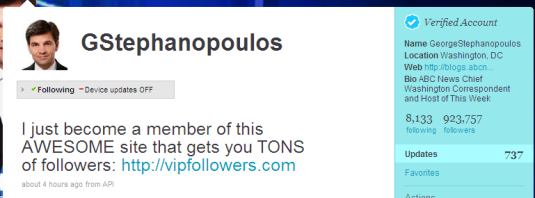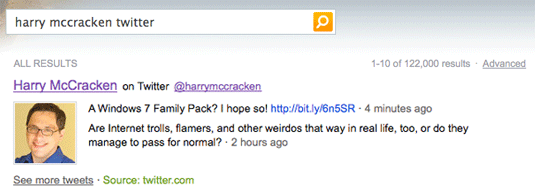If a Twitter user suddenly gushes about an AWESOME site that got him or her TONS of followers, and then provides a link to it, it’s reasonable to be skeptical–especially if that person doesn’t strike you as the type to get excited about such things or make excessive use of ALL CAPS.
And if the Twitter user in question happens to be the host of a network TV show and have close to A MILLION followers already…well, the chances are 101% that something is amiss:

Mr. Stephanopoulos is one of scads of Twitter users who have fallen victim to some sort of scam. Clicking on the links in their Tweets takes you to one of several sites that instruct you to enter your Twitter name and password to get the promises TONS of followers. And given that whoever’s behind all this has hacked into other people”s Twitter accounts to spread the word, trusting him or her with your Twitter password would be a Very Bad Idea.
I’m not sure how the phisher who’s doing this is tweeting from other folks’ accounts–it could be a known Twitter vulnerability, or one that nobody knew about until now. I’d love to hear Twitter explain what it’s doing about security other than telling folks to tread carefully.
One other note: George Stephnopoulos is one of the high-profile twitterers who has a Verified Account. But Verified Accounts don’t mean all that much if you don’t have any confidence that the tweets that emit from them are legit…

 Starbucks Coffee Company has turned to social media to promote its new ice cream brand. The bean peddler is giving Facebook users
Starbucks Coffee Company has turned to social media to promote its new ice cream brand. The bean peddler is giving Facebook users  Australian marketing company uSocial, which ambitiously (if inaccurately) describes itself as “the world’s premier advertising service,” is
Australian marketing company uSocial, which ambitiously (if inaccurately) describes itself as “the world’s premier advertising service,” is  Microsoft’s strategy with its Bing search engine seems to be, in part, to be visibly different from Google. Which is certainly the case with a new feature the company launched on Tuesday:
Microsoft’s strategy with its Bing search engine seems to be, in part, to be visibly different from Google. Which is certainly the case with a new feature the company launched on Tuesday: 
 I spent this afternoon doing what a lot of people did: Watching TV reports about Michael Jackson while also gleaning information from the Web–especially Twitter. When I happened to turn on the TV, MSNBC was still speaking of Jackson having gone into cardiac arrest; the (correct) consensus on Twitter was that he had passed away. Impressive proof of Twitter’s speed and old media’s lethargy, no?
I spent this afternoon doing what a lot of people did: Watching TV reports about Michael Jackson while also gleaning information from the Web–especially Twitter. When I happened to turn on the TV, MSNBC was still speaking of Jackson having gone into cardiac arrest; the (correct) consensus on Twitter was that he had passed away. Impressive proof of Twitter’s speed and old media’s lethargy, no? Facebook insiders
Facebook insiders